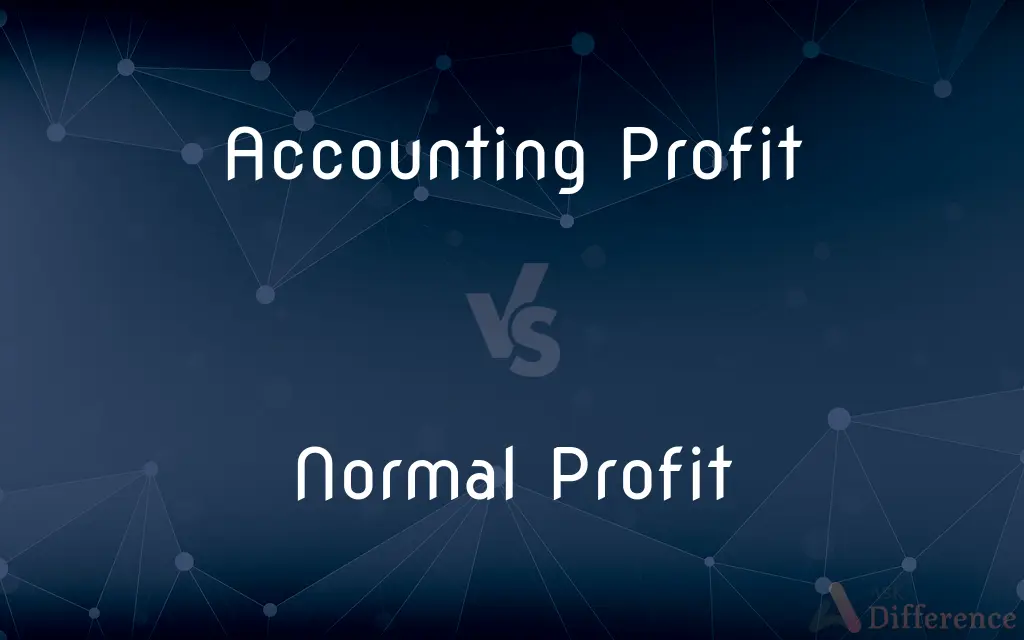Accounting Profit vs. Normal Profit — What's the Difference?
Edited by Tayyaba Rehman — By Fiza Rafique — Published on February 29, 2024
Accounting profit is a company's total earnings after subtracting explicit costs, whereas normal profit is the minimum earnings needed to keep a firm in its current industry, considered an implicit cost in opportunity cost calculations.

Difference Between Accounting Profit and Normal Profit
Table of Contents
ADVERTISEMENT
Key Differences
Accounting profit, often referred to as net income, is calculated by subtracting explicit costs from total revenue. These explicit costs include all direct expenses such as wages, rent, materials, and utilities involved in the business operations. It is a quantitative measure, reflected in financial statements, and indicates the financial performance of a business over a specific period.
Normal profit, on the other hand, is a theoretical benchmark, representing the opportunity cost of the resources employed in the business. It is the minimum amount of profit required for a company to remain viable in its current venture, essentially equating to the earnings a business owner could expect from the next best alternative use of their time and investments. Normal profit is not explicitly reported in financial statements but is an implicit cost considered in economic profit calculations.
Accounting profit provides a snapshot of a company's financial health by considering tangible, monetary inputs and outputs, while normal profit offers a more conceptual understanding, incorporating the value of foregone opportunities. Accounting profit exceeding normal profit suggests a firm is not only viable but also thriving beyond the basic incentive to stay in business.
The distinction between the two is crucial for business analysis and decision-making. Accounting profit assesses operational success and financial viability, while normal profit evaluates whether the business is a better option than alternative investments, taking into account the cost of the entrepreneur's own resources and efforts.
If a company's accounting profit is equal to its normal profit, the business is doing just enough to justify its existence in the industry, without any real economic profit. When making strategic decisions, understanding both concepts allows business owners and stakeholders to gauge both the financial and opportunity costs of their operations.
ADVERTISEMENT
Comparison Chart
Definition
Total revenue minus explicit costs
Minimum earnings to keep a firm in its current industry
Nature
Quantitative, financial measure
Theoretical, represents opportunity cost
Costs Included
Explicit costs (wages, rent, materials)
Implicit costs (foregone income from alternatives)
Financial Statements
Reflected in income statements
Not directly reported, but considered in economic profit
Indicator
Financial health and operational success
Viability against next best alternative investment
Compare with Definitions
Accounting Profit
Used for tax purposes.
The firm's accounting profit is subject to corporate income tax.
Normal Profit
Opportunity cost benchmark.
The entrepreneur's normal profit is what they would earn in their next best employment.
Accounting Profit
Based on explicit costs.
After paying for raw materials, labor, and rent, the firm's accounting profit is calculated.
Normal Profit
Not shown in financial statements.
While not recorded, normal profit is crucial for economic analysis.
Accounting Profit
Reflected in income statements.
The annual report shows an accounting profit, indicating positive financial health.
Normal Profit
Indicates industry viability.
Achieving normal profit means the firm is competitive in its market.
Accounting Profit
Indicates profitability.
A positive accounting profit suggests the company is financially viable.
Normal Profit
Assesses alternative investments.
The business is considered successful if it earns more than the normal profit level.
Accounting Profit
Financial performance measure.
A company earned $1 million in revenue and had $800,000 in explicit costs, resulting in a $200,000 accounting profit.
Normal Profit
Implicit cost consideration.
Normal profit accounts for the salary the owner foregoes by running the business.
Common Curiosities
Can a business have a high accounting profit but low economic profit?
Yes, if the accounting profit is high but close to the normal profit, the economic profit, which accounts for implicit costs, could be low.
What constitutes explicit costs in accounting profit?
Explicit costs include all direct monetary expenses such as salaries, rent, and materials.
How do businesses use these profit concepts in decision-making?
Accounting profit helps assess financial health, while normal profit evaluates if the business is the best use of resources.
Why is normal profit considered an implicit cost?
It represents the income foregone by not pursuing the next best alternative, thus an opportunity cost.
Does normal profit vary by industry?
Yes, normal profit can vary significantly across industries based on risk, required skill level, and alternative opportunities.
Is normal profit the same as break-even?
Yes, in economic terms, normal profit is the break-even point where total revenues equal total costs (explicit plus implicit).
Can a company have a negative accounting profit but still cover its normal profit?
No, normal profit is included in total costs, so a negative accounting profit implies normal profit is not covered.
Why might a firm continue operating if it only earns normal profit?
For non-monetary reasons, such as passion for the business, or in anticipation of future growth beyond normal profit.
How do investors view accounting and normal profits?
Investors look at accounting profit for immediate financial viability and normal profit for long-term sustainability and opportunity cost.
Is it possible to accurately calculate normal profit?
It can be challenging due to the subjective nature of opportunity costs and the difficulty in identifying all alternatives.
What happens if a business consistently earns just normal profit?
It may remain viable but lacks economic profit, indicating no real advantage over the next best investment.
How does inflation impact these profit measures?
Inflation can increase both explicit and implicit costs, affecting accounting and normal profits respectively.
Do all businesses aim to exceed normal profit?
Ideally, yes, as earning above normal profit indicates economic profit and a competitive advantage.
What role does risk play in determining normal profit?
Higher risk ventures typically require a higher normal profit to compensate for the increased uncertainty.
How do changes in market conditions affect normal profit?
Changes in alternatives or industry standards can raise or lower the normal profit benchmark.
Share Your Discovery

Previous Comparison
Princess vs. Empress
Next Comparison
New York vs. New York CityAuthor Spotlight
Written by
Fiza RafiqueFiza Rafique is a skilled content writer at AskDifference.com, where she meticulously refines and enhances written pieces. Drawing from her vast editorial expertise, Fiza ensures clarity, accuracy, and precision in every article. Passionate about language, she continually seeks to elevate the quality of content for readers worldwide.
Edited by
Tayyaba RehmanTayyaba Rehman is a distinguished writer, currently serving as a primary contributor to askdifference.com. As a researcher in semantics and etymology, Tayyaba's passion for the complexity of languages and their distinctions has found a perfect home on the platform. Tayyaba delves into the intricacies of language, distinguishing between commonly confused words and phrases, thereby providing clarity for readers worldwide.
















































